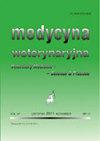Congenital Anomaly Cases in Calves
IF 0.4
4区 农林科学
Q4 VETERINARY SCIENCES
Medycyna Weterynaryjna-Veterinary Medicine-Science and Practice
Pub Date : 2023-01-01
DOI:10.21521/mw.6715
引用次数: 0
Abstract
The purpose of this study was to investigate the prevalence of congenital anomalies in calves brought to the Ondokuz Mayıs University, Faculty of Veterinary Medicine animal hospital surgery clinic between 2010 and 2020. The study material consisted of 140 calves with anomalies of different races and genders. Gender was examined for its effect on the formation of anomaly types and found to be a statistically insignificant factor (P > 0.05). Simmental calves had a statistically significant higher number of digestive system anomaly diagnoses than Holstein calves (P <0.01). Simmental calves were found to have a 2.85 times higher risk of digestive system anomalies than Holstein calves. The predisposition of atresia ani according to race or gender was not statistically significant in digestive system anomalies, but males tended to be more disadvantaged in general. Similarly, it was determined that the gender and race predisposition for atresia coli anomaly was statistically significant (P <0.05), and males were significantly more prone to this anomaly than females by 3.33 times (P <0.05). When musculoskeletal anomalies were compared based on race, the distribution of susceptibility was found to be significant (P <0.01). Simmental and Holstein breeds were shown to have a 5.84 times higher risk than other breeds in this anomaly category, with Simmental breeds having a 5.32 times higher risk than Holsteins in the Samsun region of Turkey. As a result, it was concluded that breed selection is critical in cow breeding to limit the likelihood of congenital abnormalities.小腿先天性畸形病例
本研究的目的是调查2010年至2020年期间送到Ondokuz Mayıs大学兽医学院动物医院外科诊所的小牛先天性异常的患病率。研究材料包括140头不同种族和性别的畸形小牛。性别对异常类型形成的影响无统计学意义(P < 0.05)。西门塔尔犊牛消化系统异常诊断率显著高于荷斯坦犊牛(P <0.01)。西门塔尔犊牛出现消化系统异常的风险是荷斯坦犊牛的2.85倍。在消化系统异常中,种族和性别对闭锁的易感性无统计学意义,但总体上男性更容易处于不利地位。同样,我们发现性别和种族对大肠杆菌闭锁异常的易感性有统计学意义(P <0.05),男性是女性的3.33倍(P <0.05)。以种族为基础比较肌肉骨骼异常,易感性分布有显著性(P <0.01)。在这一异常类别中,西门塔尔和荷尔斯坦品种的风险比其他品种高5.84倍,其中西门塔尔品种的风险比土耳其萨姆松地区的荷尔斯坦高5.32倍。因此,可以得出结论,品种选择在奶牛育种中至关重要,以限制先天性异常的可能性。
本文章由计算机程序翻译,如有差异,请以英文原文为准。
求助全文
约1分钟内获得全文
求助全文
来源期刊

Medycyna Weterynaryjna-Veterinary Medicine-Science and Practice
VETERINARY SCIENCES-
CiteScore
0.80
自引率
0.00%
发文量
73
审稿时长
4-8 weeks
期刊介绍:
"Medycyna Weterynaryjna" publishes various types of articles which are grouped in the following editorial categories: reviews, original studies, scientific and professional problems, the history of veterinary medicine, posthumous memoirs, as well as chronicles that briefly relate scientific advances and developments in the veterinary profession and medicine. The most important are the first two categories, which are published with short summaries in English. Moreover, from 2001 the editors of "Medycyna Weterynaryjna", bearing in mind market demands, has also started publishing entire works in English. Since 2008 the periodical has appeared in an electronic version. The following are available in this version: summaries of studies published from 1999 to 2005, full versions of all the studies published in the years 2006-2011 (in pdf files), and full versions of the English studies published in the current year (pdf). Only summaries of the remaining studies from the current year are available. In accordance with the principles accepted by the editors, the full versions of these texts will not be made available until next year.
All articles are evaluated twice by leading Polish scientists and professionals before they are considered for publication. For years now "Medycyna Weterynaryjna" has maintained a high standard thanks to this system. The review articles are actually succinct monographs dealing with specific scientific and professional problems that are based on the most recent findings. Original works have a particular value, since they present research carried out in Polish and international scientific centers.
 求助内容:
求助内容: 应助结果提醒方式:
应助结果提醒方式:


